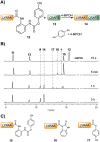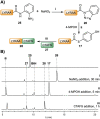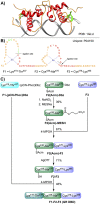A versatile o-aminoanilide linker for native chemical ligation
- PMID: 36320694
- PMCID: PMC9491214
- DOI: 10.1039/d2sc04158h
A versatile o-aminoanilide linker for native chemical ligation
Abstract
Chemical protein synthesis (CPS) is a consolidated field founded on the high chemospecificity of amide-forming reactions, most notably the native chemical ligation (NCL), but also on new technologies such as the Ser/Thr ligation of C-terminal salicylaldehyde esters and the α-ketoacid-hydroxylamine (KAHA) condensation. NCL was conceptually devised for the ligation of peptides having a C-terminal thioester and an N-terminal cysteine. The synthesis of C-terminal peptide thioesters has attracted a lot of interest, resulting in the invention of a wide diversity of different methods for their preparation. The N-acylurea (Nbz) approach relies on the use of the 3,4-diaminobenzoic (Dbz-COOH) and the 3-amino-(4-methylamino)benzoic (MeDbz-COOH) acids; the latter disclosed to eliminate the formation of branching peptides. Dbz-COOH has been also used for the development of the benzotriazole (Bt)-mediated NCL, in which the peptide-Dbz-CONH2 precursor is oxidized to a highly acylating peptide-Bt-CONH2 species. Here, we have brought together the Nbz and Bt approaches in a versatile linker, the 1,2-diaminobenzene (Dbz). The Dbz combines the robustness of MeDbz-COOH and the flexibility of Dbz-COOH: it can be converted into the Nbz or Bt C-terminal peptides. Both are ligated in high yields, and the reaction intermediates can be conveniently characterized. Our results show that the Bt precursors have faster NCL kinetics that is reflected by a rapid transthioesterification (<5 min). Taking advantage of this major acylating capacity, peptide-Bt can be transselenoesterified in the presence of selenols to afford peptide selenoesters which hold enormous potential in NCL.
This journal is © The Royal Society of Chemistry.
Conflict of interest statement
The authors declare that there are no conflicts of interest.
Figures








References
-
- Dawson P. E. Muir T. W. Clark-Lewis I. Kent S. B. H. Science. 1994;266:776. - PubMed
-
- Dawson P. E. Kent S. B. H. Annu. Rev. Biochem. 2000;69:923. - PubMed
-
- Canne L. E. Bark S. J. Kent S. B. H. J. Am. Chem. Soc. 1996;118:5891.
-
- Offer J. Boddy C. N. C. Dawson P. E. J. Am. Chem. Soc. 2002;124:4642. - PubMed
LinkOut - more resources
Full Text Sources
Miscellaneous

